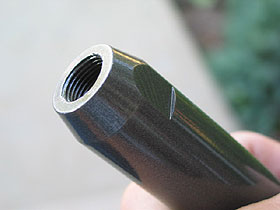 |
Introducing
Big Daddy's Offroad Monster Tie Rod (Part #TR-TJXJ2J)
for 1997 to current Jeep Wranglers. This tie rod is
designed to use OEM or equivalent tie rod ends, and
has machined "wrench flats" for adjustability.
It is a length of 1-1/4 inch DOM tubing and has been
powder-coated dark "gun metal" gray. This
tie rod weighs in at 7 lbs, includes a pair of jam nuts,
and retails for $89.00.
Big
Daddy Offroad designed this tie rod for the avid rockcrawling
enthusiast, and they claim it is four times stronger
than the stock tie rod.
"The
Monster Tie Rod will keep you confident and proud!" |
|
| How
does one review a heavy-duty tie rod? Sure, we could
install it and hope that one day we accidentally pick
a bad line that puts the tie rod on a collision course
with some rocks, or we could install it and intentionally
pick a bad line at speed to see what affect the collision
has on the tie rod and the entire front end. I'll bet
you guys would like to see that!
Instead,
we decided to attempt to destroy this tie rod in its
uninstalled state. Destroying this tie rod was the only
way for us to convey how strong it actually is to our
readers. |
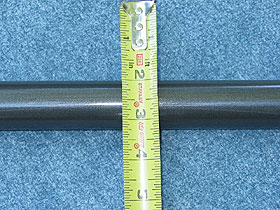 |
|
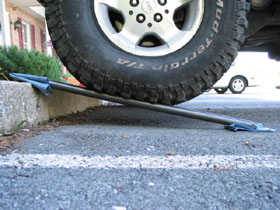 |
The
first test was easy. Can the Monster Tie Rod support
the weight of the vehicle? admittedly, there was little
doubt that the tie rod would easily pass this test,
given the length of the tube, the beefy physical characteristics,
and the weight of the vehicle spread over a good area.
The
tie rod could support the front of a Jeep Wrangler without
flexing, but what would we have to park on it to determine
its bending point? After considering many alternatives,
I put a bit more thought into a means of destroying
the tie rod, which brings us to our next test. |
|
WARNING:
Do not reproduce this test. This test was performed
in a remotely located, controlled environment. Many
precautions were taken to ensure our safety. This
test demonstrates improper winch use and should not
be attempted under any condition.
In
the woods, we rigged the tie rod up to a tree strap
and pulled the tie rod from its center with a 9500 lb
winch. Although we had no way to measure how many pounds
of force were being issued to the Monster Tie Rod, we
were determined to do our very best to bend it. How
easy or how difficult it was to do so would give us
a way to convey to you roughly what the bending point
of the tie rod is. Many of you are familiar with winching
and the forces involved.
Initially,
the tie rod barely flexed at all. As we winched, it
began to pull the Jeep toward it, wheels locked, while
maintaining its shape. This was effectively phase one
of the winch test, and it passed with flying colors.
For
phase two, we anchored the back of the Jeep using another
tree strap, and clevis, and continued winching. The
9500 lb winch began to strain under the load, and the
voltmeter inside the Jeep pegged to zero. We stopped
pulling just before we thought the winch was about to
stall completely.
Upon
inspection of the Monster Tie Rod, we immediately noticed
that we had accomplished that which we set upon doing.
The Monster Tie Rod was effectively trashed, as it had
apparently slowly bent into a "V" shape while
it was being pulled.
Based
on the manufacturer's specifications of our 9500 lb
winch, on approximately 3 wraps of cable, we estimate
that we were exerting between 7000 to 8000 lbs of pressure
to the center of the tie rod. This is not necessarily
an accurate estimation because it largely depends on
the output of our Jeep's electrical system, but it should
be in the right ballpark.
These
are good results. |
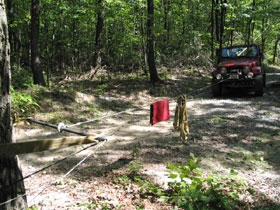
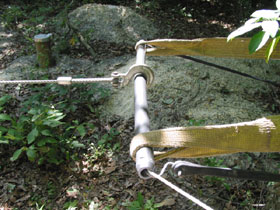
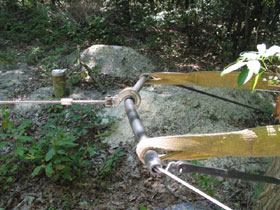
|
|
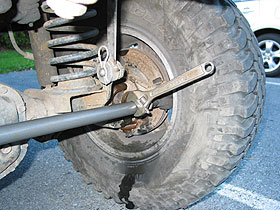 |
The
machined "wrench flats" are worth their weight
in gold. Many aftermarket tie rods are manufactured
with wrench flats nowadays, but not all. In this case
we used an adjustable wrench to turn the tie rod onto
the ends, and it installed extremely easily. Never having
owned a tie rod with "wrench flats" before,
we found ourselves highly amused by the novelty of the
concept.
With
ease, we installed the tie rod in our parking lot, and
temporarily straightened the steering wheel until our
front end alignment appointment. A proper front end
alignment is required after such a tie rod upgrade,
because improper alignment can adversely affect handling
and tire wear. We recommend getting it close and driving
to the alignment shop for accurate alignment. |
|
| We
replaced our Challenger Performance Alumiflex Tie-Rod,
reviewed here,
simply for the sake of trying something different. In
the picture to the right, you can see the effect a pipe-wrench
had on the Alumiflex tie rod. I sure wish the Alumiflex
had "wrench flats" like the Big Daddy Monster
Tie Rod.
The
cosmetic differences between the Challenger Performance
Alumiflex Tie Rod and the Big Daddy Monster Tie Rod
are readily apparent, but physically, we're comparing
apples to oranges. The Alumiflex is designed to bend,
while the Monster is designed to not bend. |
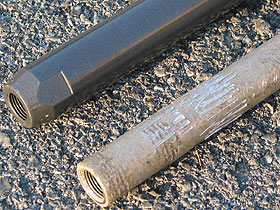 |
|
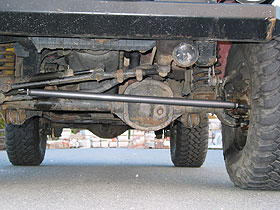 |
One
thing I want to add is that anti-seize should be applied
to tie rod ends before installing an aftermarket tie
rod - the Alumiflex in particular, which seemed to bond
(or corrode) slightly to the tie rod ends after a year
of being installed without using anti-seize. This is
a characteristic of aluminum when it comes in contact
with a dissimilar metal for a long period of time.
The
Monster Tie Rod is much better in this regard with its
thorough powder coating. It may be prone to eventually
seizing at the rod ends threads from iron oxide, but
this is commonplace among steel front end parts and
generally not a problem. |
|
| Many
heavy duty tie rods from other manufacturers are being
offered with stronger tie rod ends, usually from Dodge
truck applications, and for a good reason. We bent a
Monster Tie Rod with several thousand pounds of force.
If we were to impact a rock with a similar amount of
force, the Monster might stay perfectly straight, but
that force is going to pass straight through the Monster
to the next front end component. In place of a bent
tie rod, one might have a broken tie rod end, a bent
drag link, or a broken knuckle - all of which would
be worse than a bent rod.
A
flexible, aluminum alloy, tie rod is going to better
absorb the energy of an impact, and be less strenuous
on contiguous front end components, thus making part
failure even less likely while returning a usable tie
rod. |
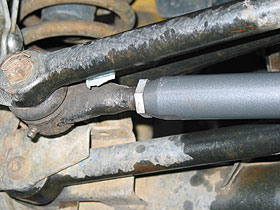 |
|
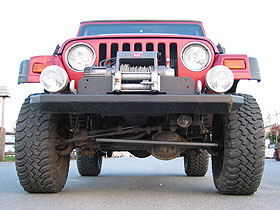 |
The
negative effects of kinetic energy aside, most moderate
four-wheelers will not encounter a "worst case"
situation where stress applied to the Monster tie rod
will translate into broken parts. The Monster tie rod
offers an extreme improvement over the stock tie rod.
The
Big Daddy's Offroad Monster Tie Rod is a great choice
for the rockcrawling enthusiast who is looking for a
stock tie rod replacement that offers high strength,
superb craftsmanship, and maximum beefiness without
having to replace additional steering components. It
will deflect most glancing blows and minor rubs without
incident, so you can run the rocks with your mind at
ease!
|
Big
Daddy's Offroad Monster Tie Rods are available at www.4x4rockshop.com
|
|